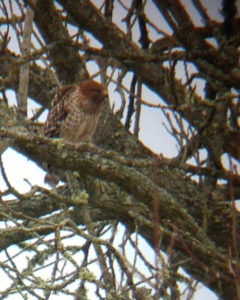Kick off the New Year with the Christmas Bird Count
A guest blog for VNC from Audubon Master Birder Ezra Parker

Ezra Parker and Bianca Perla count birds at Maury Marine Park as the first snow flakes start to fall. Photo courtesy of: Harsi Parker
As a grand finale to your holiday season, consider ringing in the New Year by participating in the Vashon-Maury Island Audubon Society Christmas Bird Count (CBC). This year’s Vashon CBC will take place on Monday, January 2, 2017, from dawn to dusk, followed by a potluck gathering at the Land Trust building at 5:00 p.m
The annual Christmas Bird Count is the longest-running citizen science project in the Western Hemisphere, and one of the largest in the world. The CBC comprises a census of the individual birds found within more than 2000 15-mile diameter count circles all across the region, with most located in the United States and Canada, but growing participation in Mexico, Central and South America as well as a few Pacific islands.
The Vashon count regularly records around 115-120 bird species, and recent counts have featured rarities such as Yellow-billed Loon, White-breasted Nuthatch and Red-shouldered Hawk. Our count circle includes all of Vashon and Maury islands, a section of the Kitsap Peninsula along Colvos Passage and most of Blake Island to the north.
As this is a huge area, we’re looking for as many volunteers as we can find to help cover as much of it as possible. There are several ways to participate for people of all skill levels:
1. Join a team in the field
A number of field teams will venture out to cover particular portions of the count circle, including all of the various birding hot spots. Teams generally spend most or all of the day in the field, and observers with a team can expect to record around 30-50 species with the guidance of experienced team leaders.
2. Count birds at your feeder
If you don’t have the time or inclination to join one of the field teams, you can still help out by counting the birds at your feeder (or anywhere on your property). Birders of any skill level can contribute by spending just a few minutes counting their yard birds.
3. Owling parties
There will also be one or more owling parties heading out from 3:00 or 4:00 a.m. until dawn in the hope of hearing some owls calling.
Finally, at the end of the day we’ll congregate at the Land Trust building for our wrap-up potluck, where the stalwart birders who make this event happen share their triumphs and disappointments.
This year the CBC compiler and organizer will be Ezra Parker. Please contact him at 206-463-0383 or ezra@cfgrok.com if you’re interested in taking part in the count.

A view through a spotting scope of a red-shouldered hawk. This was a first record for Vashon! Photo courtesy of: Harsi Parker
Below is a summary of last year’s count:
Last year’s Christmas Bird Count was held on Sunday, January 3, 2016, marking the 17th year for the Vashon count circle. There were a number of firsts on last year’s CBC, starting with the weather. While it was not the coldest day we’ve had for the survey, it was close, and this was the first time we have had snow on the count, with flakes starting to fall in the late morning hours, and heavy flurries in some areas by early afternoon. While the conditions were definitely challenging, we still had record-setting participation, with more observers and hours spent counting than in any previous year.
Generally, most teams reported that it was rather quiet, with low overall numbers, and a noticeable decline in bird activity as the day progressed and the snow moved in. That said, while a little below average (down about 6%), the total of 20,436 individual birds counted was actually higher than the last two years, probably due at least in part to the dedication of our stalwart participants. The species count ended up slightly above average with a total of 116 species on count day, and an additional 5 records for count week.
The highlights of the day included several novelties for the count, including the island’s first record of a Red-shouldered Hawk, found by Ed Swan and Jean Olson adjacent to the Land Trust’s Matsuda Farm property. As there are only a handful of historical records for this species in King County, this was a pretty rare find, and certainly a surprise! After further investigation, it turned out that the bird in question had been present in the area since at least mid-November. It also continued for a while after the count, and was seen nearby as late as mid-February.
Some other unexpected firsts for the count were two insectivorous species that really should be nowhere near this far north in the winter months, as well as a grassland species that is uncommon for our area. The first of these was another rare find, an Ash-throated Flycatcher seen during count week, also in the vicinity of the Matsuda fields. This bird was originally located about a month before, first by Alan Warneke, then Erik Steffens, at which point it disappeared, only to shockingly reappear briefly on the last day of the year, just in time to make it onto our list for the count. A day after the count, Karen Fevold also located a Western Meadowlark on a nearby private field – evidently the Matsuda area is quite the magnet for unusual birds!
The other very odd sighting was a lone Violet-green Swallow spotted coursing over Long Lake out on the Kitsap Peninsula by Ken Brown and Ed Pullen. In contrast to the flycatcher, this is a common species for our area, but is certainly not expected at this time of year. Unfortunately, it will be a challenge for both of these birds to survive the winter, as the primary reason that insectivores head south in the fall is the lack of adequate numbers of aerial insects to sustain them during the winter months.
In addition to these new species for the Vashon count, a Northern Shrike was seen out in Kitsap for only the second time. There were record high counts for a fair number of species, including Cackling Goose (70), Northern Shoveler (268), Lesser Scaup (60), Harlequin Duck (41), Sharp-shinned Hawk (11), Virginia Rail (5), Killdeer (138), Eurasian Collared-Dove (18), Western Screech-Owl (2), Anna’s Hummingbird (150), Hairy Woodpecker (9), Northern Flicker (185), American Kestrel (5), and Common Raven (57).
At the other end of the spectrum, there were a couple notable misses, chief among them Black Scoter and Rhinoceros Auklet. Rhinos had been seen in 15 of the 16 previous years of the count, and this was the first time we did not find a single Black Scoter. We also almost completely missed the iconic Western Grebe, as none at all were found on Vashon/Maury, with only 5 birds detected by the team in the Purdy area on the peninsula. This is a stunning decline from the numbers seen only a few years ago (453 in 2013) and a decline of over 99% from an average of 1181 over the history of the count. Other record lows include Wood Duck (8), Ring-necked Pheasant (1), and Great Blue Heron (19).
With overnight low temperatures staying well below freezing, most of the ponds in the area were frozen solid, and this certainly had an impact on the distribution of species such as Wood Duck, Ring-necked Duck and Pied-billed Grebe. None of these birds typical in freshwater habitats were found on the island, although the latter two were both seen in high numbers elsewhere in the count circle.
Results for the saltwater species were somewhat mixed, with above average numbers for some species, such as American Wigeon (3744), Common (520) and Barrow’s Goldeneye (196), Red-throated Loon (95) and Brandt’s Cormorant (100), but lower numbers for others like Surf (871) and White-winged Scoter (375), Horned (382) and Red-necked Grebe (76), Common (26) and Pacific Loon (20). While the Surf Scoter numbers were not the biggest departure from the historical average (for example, this species is down about 19%, while Pacific Loon is off by 71%), their counts on the survey are generally more consistent from year to year than other species that are seen in smaller overall numbers, so it’s worth mentioning that the last time fewer than 1000 were recorded was 8 years ago.
This was definitely a good year for both diurnal raptors as well as owls, with numbers above average for almost all species, and the only real miss for the day being a Peregrine Falcon. Otherwise, in addition to the Red-shouldered Hawk, no less than 5 American Kestrels were found on Vashon, along with a Northern Harrier in Kitsap, and above-average numbers for Sharp-shinned Hawk (11), Cooper’s Hawk (6), Bald Eagle (54) and Red-tailed Hawk (24). Several owling parties had great success, and managed to find Western Screech-Owl (2), Great Horned (3), Barred (4) and Northern Saw-whet Owl (2), as well as a count week Barn Owl.
Woodpeckers were seen in high numbers across all 5 regularly-occurring species, and doves were mostly up as well, with the two native species both significantly above average, and Rock Pigeon (216) slightly below. While 18 Eurasian Collared-Doves is not a large number, it is still triple the previous high count from a few years ago – it will be interesting to watch the increase in our area as they continue their steady march across the continent.
On the passerine front, numbers were higher for the majority of species, with a few notable exceptions. Finches were low across the board, with the biggest decline being Red Crossbill (14) at 67% below the average. Two species typically seen in large numbers, American Robin (1033) and European Starling (612), were both well below their averages, down 36% and 47%, respectively. Ruby-crowned Kinglet (90) was also off by about 24%, but most of the other common winter species were up, particularly sparrows. Some of the biggest increases being Varied Thrush (142) at 60% above average, Fox Sparrow (157) and Golden-crowned Kinglet (454) at 44%, and Dark-eyed Junco (1428) at 41%. We had pretty good luck this year with many of the difficult-to-find species as well, including Hutton’s Vireo (7), Hermit Thrush (9), Cedar Waxwing (14), Orange-crowned Warbler (count week), Yellow-rumped Warbler (4), Townsend’s Warbler (2), White-throated Sparrow (1), Lincoln’s Sparrow (1), and Evening Grosbeak (1).
All in all, it was a very successful count, particularly given the unexpected adverse weather conditions for the day. Our thanks to the fantastic group of participants who made this happen – we couldn’t do it without you!

Hi, all – well, I can’t hold up binoculars, and don’t often know the kind of bird I see, but I’ll go to a friend’s feeder and count, and maybe head for the Judd Creek Loop! Or Fisher Pond.
Thanks for the sensible critique. Me & my neighbor were just
preparing to do some research on this. We got a
grab a book from our area library but I think I learned more from this
post. I’m very glad to see such fantastic information being shared
freely out there.